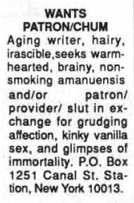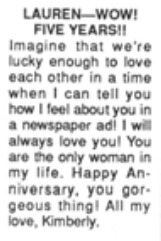#outweek
Text
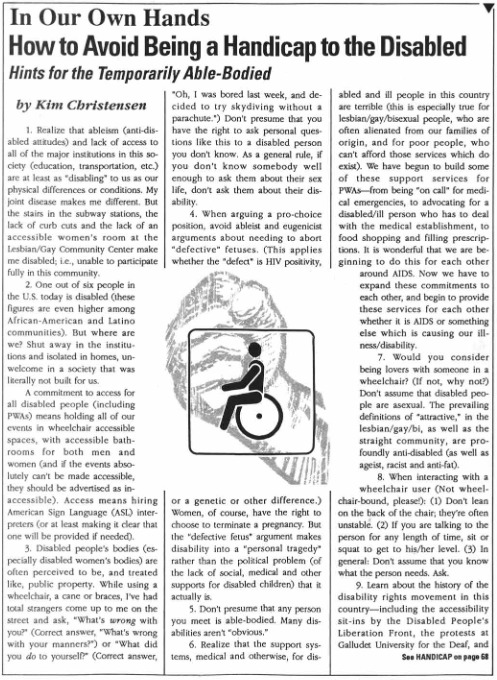

"How to Avoid Being a Handicap to the Disabled: Hints for the Temporarily Able-Bodied" By Kim Christensen, in OutWeek Magazine issue 11 (1989)
#queer history#outweek#cripple punk#actually disabled#ableism#disability rights#disability activism#disability history#cpunk
421 notes
·
View notes
Note
hey, do you have any book suggestion about queer activism and lesbian history? I wanted to start reading more about it. thank you if you do!
hi❣ as you might be able to deduce from the types of historical stuff i tend to post, i'm most of all interested in primary sources. so from my own reading experience i can't really recommend you academic, modern nonfiction books that compile lesbian/sapphic history from many different sources. the books i've read have almost exclusively been published diaries of lesbian/queer people from the past, such as the lesbian crushes trilogy by natasha holme or we both laughed in pleasure by lou sullivan. as well as the diaries and letters of more mainstream figures like virginia woolf, frida kahlo, or emily dickinson - which,, depending on the editor and publisher, usually don't zoom in on the queer aspects of their lives.
i can, however, recommend and link my favourite lesbian/sapphic periodicals, magazines, and other publications. you can read countless of them online for free! i can also link some google drive archives that include a large number of books on queer activism, lesbian/sapphic history, and other lgbt topics - again, i haven't read most of these back to back myself, but i've heard good things, and at least you'll have a place you can find many of them if you get recommendations from someone/somewhere else! 💙
periodicals, magazines, etc.:
💕common lives/lesbian lives
💕the lesbian tide
💕come out!
💕the gay liberator
💕the rest of jstors lgbt collection
💕outweek magazine
💕transsisters: the journal of transsexual feminism
💕queer zine archive project
google drive archives of books, essays, etc. (with examples of some famous titles you can find inside):
💕1
- odd girls and twilight lovers: a history of lesbian life in twentieth-century america by lillian faderman (1991)
- transgender history by susan stryker (2008)
💕2
- bisexuality: a critical reader by merl storr (1999)
- straight: the surprisingly short history of heterosexuality by hanne blank (2012)
💕3
- odd girls and twilight lovers: a history of lesbian life in twentieth-century americaby lillian faderman (1991)
- the persistent desire: a femme-butch reader by joan nestle (1992)
- boots of leather, slippers of gold: the history of a lesbian community by madeline davis and elizabeth kennedy (1993)
- transgender warriors: making history from joan of arc to dennis rodman by leslie feinberg (1996)
hope you find something to your liking! i have a lot more resources as well, if you end up wanting more of something specific!
9 notes
·
View notes
Photo
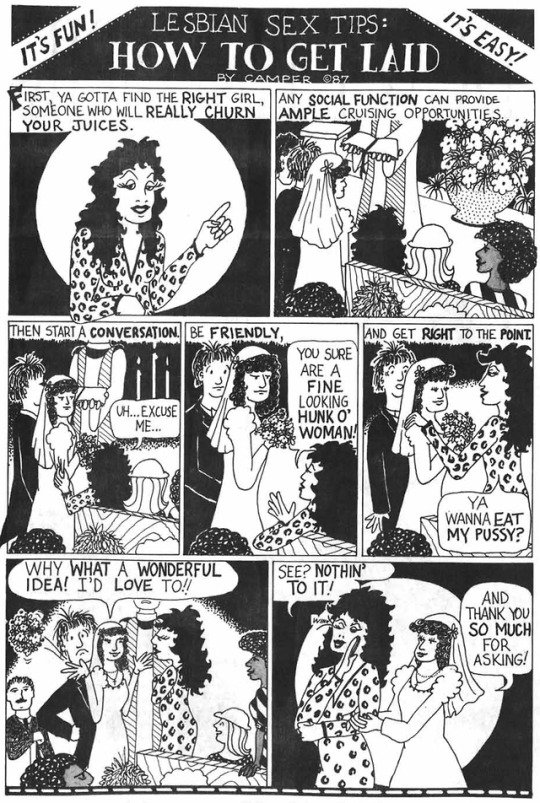
Comic by Jennifer Camper, OutWeek Magazine No. 7, August 7, 1989, p. 47.
2K notes
·
View notes
Text
CLONE CONSTRUCTION
' We LOVEDMichelangelo SignoriIe's article "New Clone VB. Old Clone" [no. 72, Nov, 28]. In fact, we loved it so mch, we wanted to help out and add on to the already-humorous but truthful list. We are sure these will not be the only additions.
p.5 http://outweek.net/pdfs/ow_76.pdf
Thanks again for making usl aughl , • • Richard Hunter Michael Tresser Jal1]esLynch Manhattan any pOlitical gay movement. That was "their" realm over In the Wast Village. It would seem the desire to separate 'from the "old clone" was much deeper than Mlchelangelo believes. Throughout the '80s, when gay men were screamIng and pleading that their • \ • , Contrary to Michelangelo's statement that it Is the "old clone" who Is "aggressively apolitical," the reveree was Initially true: Those who hung out In BoyBar and Pyramid In the mld-'80s (from where the "new clone" actually emerged) were quite adamant 'about not being Involved In , , , • • brothers were dying, the "new clone" was remarkably si.lent. In 1985, AIDS was, after all, an "old clone" disease. It was "their" disease, and we, of course, were younger and smarter and going to live forever...until we started to get sick in everincreaSing numbers ourselves. AIDS mobilized the' "new clone," not when the threat was' knockil,1g, but 'Nhe'n It was already Inside the house. I resent the Implication t~at gay politiCS were somehow meaningless before groups like ACT UP and au~er Nation came into being. While It is fun to imagine that this , , , activism is some brainstorm tha't has never been done· before, I am amazed how far some will contort to pat them-, , , I selves on the back John Maresca Manhattan Michelangelo Signorlle responds: You are absolutely correct that the new clone 'look was first worn by the then-complacent BoyBar and Pyramid crowd; however, the activists' soon adopted it-and many in that East . Village crowd later actually became activists themselves. But the pOint you make is on tlirget, as Is your second point about AIDS first being .an old clone disease. However, to say that I Implied that activism in the gay commu- 'nity began with the new clone is quite a reductive lreading of the piece. I spoke consistently of the "new" activism, realizing that,' of course, there was much that
0 notes
Text
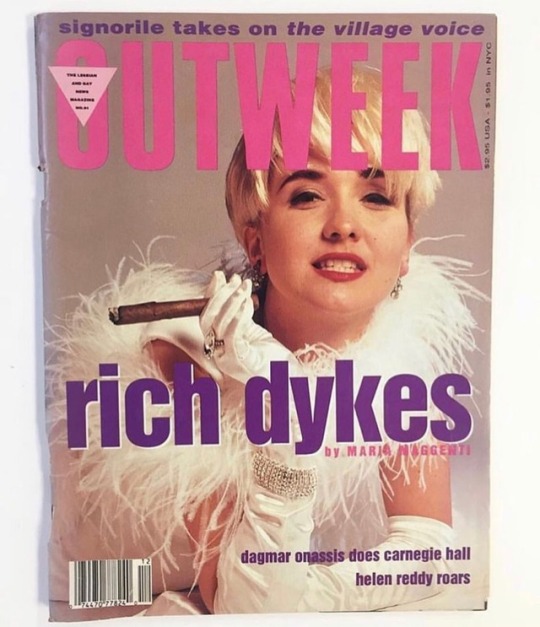
my people
0 notes
Text
[“In January of 1989, Peter Staley was planning his zap occupation of the Burroughs Wellcome headquarters in Research Triangle Park in Durham, North Carolina. He wanted to have a meeting with people in the company first—to set up the issues and let them know what our concerns were. He invited Mark to come as the “science guy.” So the two of them went to the building—Peter said, Oh, that’s a really nice fountain, that would look really great dyed red, blood red, in a demonstration. And the PR woman “sort of grabbed his arm and said, Let’s go in here, where the meeting’s going to be.”
One of the reasons people were so willing to take Burroughs Wellcome’s product, AZT, when it really didn’t work was that most people at the time were conceptualizing the treatment for AIDS as one pill that would fix everything, and AZT fit that fantasy. But even while Burroughs Wellcome was selling AZT, the highest-profit-making pharmaceutical in the world at the time, both it and the citizen scientists in T&D were starting to realize that combination therapies were the concept for the future. At the headquarters, Mark and Peter met with Dr. David Berry, who was the head researcher, and had been actually involved in the AZT teams since the very start.
They had a “very stimulating, weird conversation” with him about science and business and price. And Berry said, The only way to treat HIV, which mutates so rapidly, is going to be with powerful combinations of drugs. That’s the direction this disease is moving in. In that respect, he was very aware. Mark and Peter were saying, AIDS is a problem around the world, not just in the United States, and your price for AZT is way too high here, and it’s totally out of reach for people in Africa. And Berry retorted, Even if it was free, they wouldn’t be able to use it in Africa. He floated the argument that drug companies still use about infrastructure, poverty, and illiteracy restricting medical treatments in developing countries. Mark was so affected by Berry’s attitude that he came home and wrote an article for OutWeek called “Interview with a Vampire.” It was Mark’s first exposure to drug company people. He thought Berry was evil, at the time. In retrospect, with much more exposure, Mark now considers him to be a fairly typical drug company scientist. Later, Mark and Peter did the fountain action and got arrested.”]
Let The Record Show: A Political History of ACT UP, New York, 1987-1993, by Sarah Schulman
148 notes
·
View notes
Quote
Gay activists Kevin McFadden and Ruth Willis shocked the Boston gay and lesbian community when they got married on Gay Pride Day in 1988.
"Kevin was one of the most visibly gay men in Boston," says fellow activist Don Gorton. McFadden's gay accomplishments included running as an openly gay candidate for state senator in 1986 (MCFadden received 35 percent of the vote), organizing a 1987 gay and lesbian "town meeting" with Larry Kramer and, with his lover, Will Hutchinson, serving as the emcee of Gay Pride in 1987.
"Loyal, dedicated and highly respected," Ruth Willis was, like Kevin, involved in local gay and lesbian politics as the clerk for the Gay and Lesbian Alliance of Greater Boston, where she and her lesbian lover met Mcfadden and his gay male lover, McFadden had been a former vice chair of the Alliance, while his lover was 1986-87 chair, Willis' lover, Cathy Pearlman, had been the Alliance's PAC treasurer.
"Will and Kevin broke up at the same time [April 1988] that Ruth kicked her lover out. So Kevin moved in with Ruth as a temporary arrangement," Gorton recalls. They dropped out of the Alliance and lost touch with friends, "then they sent wedding announcements to all their gay friends," Gorton remembers. Although Ruth had been married before (with four kids) and had "never used the word 'lesbian,' ... it was quite a shock ... I don't know if they're bisexual or not."
"The Bisexual Revolution" by Carrie Wofford, Outweek #84, 1991
140 notes
·
View notes
Text

"10 Reasons Why You Should Be a Lesbian" by Liz Tracey
OutWeek magazine, issue 10 (1989)
#queer history#lgbt history#outweek#lesbian#lesbian history#wlw#saphic#lesbian pride#queer writers#queer community#lgbt writers#Liz Tracey#wlw community#queer stuff#lgbtqia history#1989#1980s
55 notes
·
View notes
Text


“Buffalo Girls, Won’t You Come Out Tonight…” Outweek, June 6, 1990
5 notes
·
View notes
Text
The [bisexual] revolution isn't only confined to the East. In June [1990], ACT UP/San Francisco was offered a chance to address the Lesbian and Gay Freedom Day Parade of the nation's largest Pride celebration. The Women's Caucus of ACT UP nominated one of their most outspoken members, Rebecca Hensler. When the decision was announced to the general body, however, an older lesbian objected to being represented a gay Pride by a bisexual, even though ACT UP isn't a gay, lesbian or bisexual group per se. The debate sparked a heated battle in which other women formerly thought to be lesbian came out to the group as bisexual. The Women's Caucus ended up falling apart--due in large measure to the tensions between bisexual-feminist and lesbian-feminists, both of whom called themselves "dykes."
--Carrie Wofford, "The Bisexual Revolution: deluded closet cases or the vanguard of the movement?," Outweek, Feb 6 1991.
85 notes
·
View notes
Photo
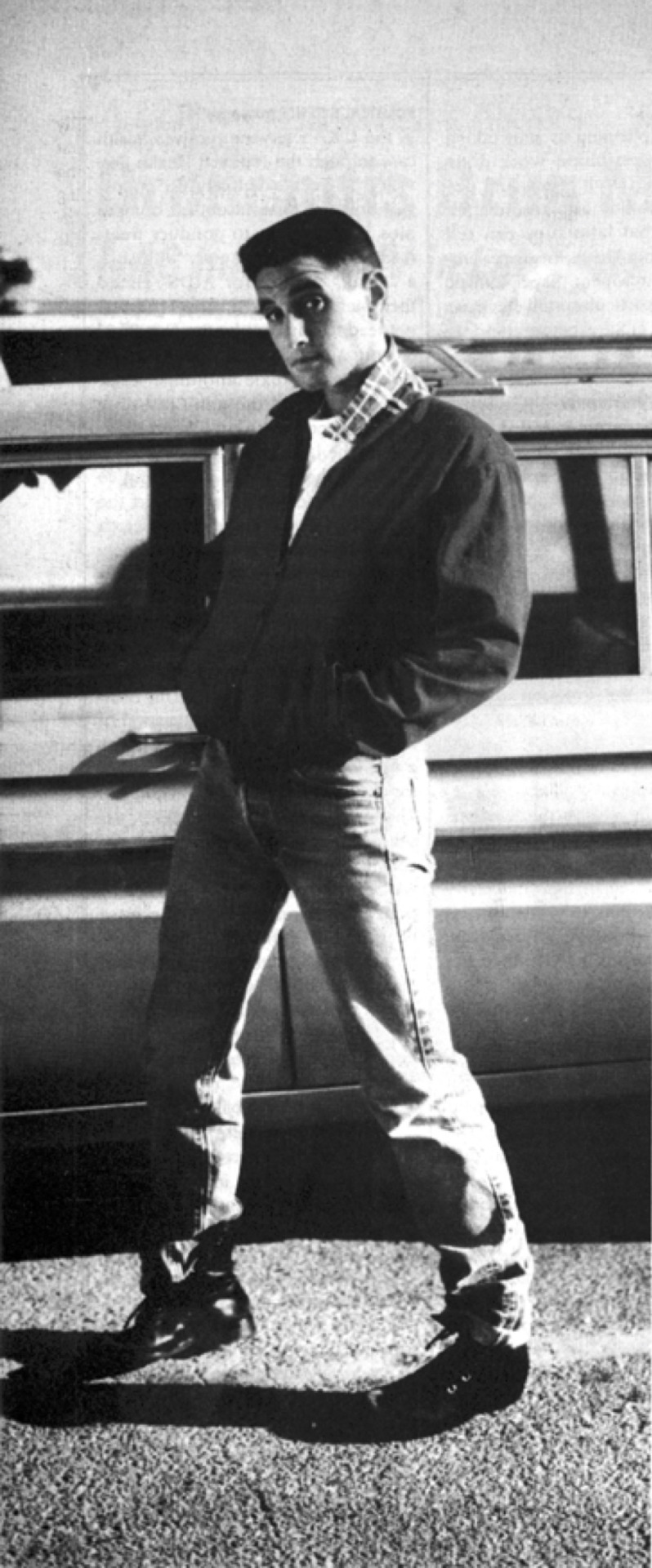
"I never know when I get on stage what it's going to be like. So we're down in New Orleans, in the middle of nowhere, and the audience is completely white. And· I'm thinking, 'Okay, if the shit is going to hit the fan, it's gonna hit tonight.' So I go on stage, do a song, come out as a lesbian, and they totally cheer, and I think, 'Okay, over that hurdle.'
"Every place we went I kept thinking, 'Well, I don't know about tonight.' But everything was great, all through the South, up to Chicago, Ohio, and it was great."
[Phranc] pauses, lowers her voice and begins pacing her words.
"Then we crossed over into Toronto. And I get on stage, and that audience ... I have never run into such a hostile, homophobic audience, just full of complete hatred, in a long, long time. They called me 'You fucking faggot. Dyke. Queer. Cunt. Fuck you. You suck. Faggot. Cunt.' 30 minutes straight, nonstop abuse. And it wasn't just two or three of them, either. It was entire chunks of the audience."
Did she continue playing?
"Yeah, because if you walk off the stage, they win. What I did was, I took out a few of the more quiet, vulnerable songs, because this was not a listening audience. And instead of playing 45 minutes, I played for 30 minutes. I ended with the song about the polar bears [that ate the Brooklyn kid], and then I stopped And I looked at the audience, and I talked to them. And I said [her voice is calm, but firm], 'Now, I've been called every name in the book tonight. So let's talk a little about tolerance and acceptance in the world. Don't you think people should be able to grow up and be whoever they are? Do you want somebody to tell you who you can and cannot be? I'm gonna dedicate this next song to you, ’cuz you're the audience who needs to hear this.' And I did "Take off Your Swastika," the most passionate, burning version I think I've ever done in my life.
"The thing that really hurt me was that there were women yelling those things to me also. But in the end, I felt like I won, and it was good, because that's what consciousness raising is, ya know. You don't do a lot playing the real easy gigs. It's great to play for people who love you, like on the women's music circuit. But I feel that my job is to go out into the big world. Ya never know who you might reach out there."
— Victoria Starr, "Folksingers, Amazons, and Other Tall Tales: An Interview with Phranc," OutWeek Magazine No. 19, October 29, 1989, p. 38. Photo by Maria Perez.
#outweek#issue 19#lgbt history#music#lesbian#phranc#feature#homophobia#victoria starr#photo#maria perez
404 notes
·
View notes
Text
MORE CLONE DRONE
p. 7-8 After reading the article on the Clones, old and new, in issue no. 74 ["Clone Wars," Nov, 28], I must seriously question where your author did his research.
"For the first time, homosexual men had actually created a uniform which would help them identify themselves." If anything, the clone look of the '70s was a reaction to the then-standing uniform of cashmere sweater and corduroy pants, which was every bit as much a uniform as the button-fly and plaid flannel. This should also give your author a little more insight into the genesis of the uniform: For years, gay men had been portrayed as wispy queens-appropriating the straight look was our way of saying that we were (and continue to be) just as masculine as the straight guys. This was not "internalized homophobia," as you r author suggests, but a reaction to a straight community that wasn't willing to concede that two men could be both gay and butch.
Insofar as the Clone look was a very white, middle-class one, again, one must look at the historic context. Most gay Blacks were more concerned with racial rights than sexual ones, and a lot of the energy of the movement in those days was diverted into support for racial civil rights; as always, we thought of ourselves last. The Clones, however, refused to think of others first; like the drag queens, we made sure people knew we were gay men, first and foremost. The infamous hankey code that the author derides as "big children playing their own games" was, for the most part, mindless fun as well as sexual communication. Maybe Mr. Signorile sees sex as a political act, but for the Clones, sex was fun so why not make a game out of it?
Those who felt excluded from the Clone movement...well, sorry, no sympathy. No one held a gun to their heads to say they had to adopt the Clone look, and a lot of gay men and women I know saw it as just another costume, much like leatherman or radical dyke or drag queen; and when you cut through it, that's all it was, just as the Clone of today wears a costume some people may find intimidating or (dare I say it?) oppressive.
To say we were elitist is, for the most part, sour grapes. I'm not an especially attractive man, but I adopted the Clone look and, through it" made many good friends. One of the joys of San Francisco in the '70s was its amazing versatility; if one so chose, he could be a Clone one night, a leatherman the next, part of the "queer intelligentsia" the night after that, One of my dearest friends (now departed) was a female impersonator in the drag-court system who was, in the vernacular of the time, ''flawless"-ne was also president of one of the Folsom Street motorcycle clubs and, when dressed in leather, looked like someone you wouldn't want to meet in a dark alley (Then again, maybe you would), If anyone was elitist in
those days, it was your politically correct "queer intelligentsia," who spent more time trying to "justify" the gay community to the straight one, like a mother trying to explain a difficult child to his or her teacher. The Clones simply were; we showed the straight community that it was possible to be gay, to be a "real man" (whatever the hell that was), to have fun and to not give a goddamn about what anyone thought of it. Finally, to correct some of the more superficial errors in the article:
1. A Clone's hair was not "heavily barbered"; it was cut about three quarters of an inch short, which made it easy to maintain. You trick, you take a shower afterwards, you towel-dry your hair, and you're ready, No Clone worth his salt went near a blow-drier.
2, AI Pacino's Cruisin' was about the New York leather community, not the Clones.
3. "The Old Clone doesn't use the word 'Clone' at all." To the contrary, one of the fastest-selling T-shirts on Castro Street in that era was a white one with the word silkscreened on it. We knew who we were, and we revelled in it.
Sean Martin
Montreal
0 notes
Photo


models Jeno Lee and Jaemin Na pose for the 1989 November edition of OutWeek
#vibez.#jeno#my boyfriends boyfriend#professional face havers and gayfakers#good at thier jobs i must say!!!!!!!!!!!!!!#aesthetic#mine
15 notes
·
View notes






